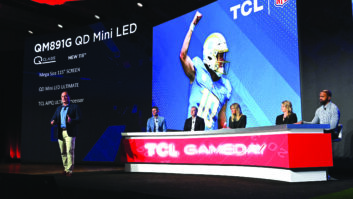The showdown between quantum dot LED LCD TV technologies and LG’s next generation of OLED TVs was long expected to take center stage at last week’s International CES, but as market research firm Futursource Consulting pointed out, the show was not without a few surprises.
Perhaps the biggest eye opener was the announcement by Samsung that a multi-company alliance to further the standards and performance of Ultra HD had formed. The Ultra HDTV Alliance is represented by some of the CE industry’s biggest TV concerns: DirecTV, Dolby Laboratories, LG Electronics, Netflix, Panasonic, Samsung Electronics, Sharp, Sony Visual Products, Technicolor, Walt Disney Studios, Twentieth Century Fox and Warner Bros. Entertainment.
“The real boost to the industry is the announcement here at International CES of the UHD Alliance, a global coalition of leading film studios, TV brands, content distributors, post-production and technology companies that aim to create a unified criterion for premium UHD platforms,” noted Jack Wetherill, Futuresource senior market analyst.
Futuresource figures for UHD’s share of global TV sales call for: 1 percent in 2013; 5 percent in 2014; 11 percent in 2015; and 19 percent in 2016.
The group’s mission is to ensure “that all of the links in the chain — from the production, distribution and consumption of content to the playback capability of devices — meet the identified premium quality standards, whilst embracing standards that are open and allow flexibility in the market yet give consumers confidence that they can watch the content they want on their devices.”
The news was welcomed by Futuresource,
“UHD is being pushed hard by TV vendors keen to extract profit from the notoriously difficult business of making margin from TV sets,” said Wetherill. “One of the big concerns, though, has been whether consumers would really see the benefit of having a 4K screen. It requires more than just a high pixel rate to deliver the wow factor, as there are benefits to be gained from wider color gamut, high dynamic range and immersive audio.”
As for UHD content, some of the more noteworthy new providers included Dish TV, which unveiled pending 4K service and 4K Joey receiver, while Netflix reaffirmed an earlier announcement that it would be adding support for High Dynamic Range (HDR) to its 4K content later this year.
“Without doubt, UHD is on the ascent, with Sharp and LG also showcasing 8K in Vegas, although we believe this market will be restricted to the Far East for some years to come,” Wetherill said.
As for the battle between OLED and quantum dot, the outcome is less certain.
Wetherill observed that OLED sets were under-represented, with LG coming to terms with high production costs.
“Emerging from the shadows is quantum dot technology,” Wetherill pointed out, “which offers much improved contrast, but at a fraction of OLED’s cost. Samsung has released its mysteriously named SUHDTV. Meanwhile, LG — while still pressing forward with OLED releases — is hedging its bets with quantum dot models too.”
Panasonic offered an OLED demo in booth, but the set was still a prototype. “Unless costs come down dramatically, the quantum dot will suffice, leaving OLED as famous for its price as for its impressive blacks,” Wetherill said.













